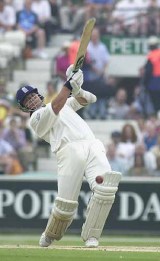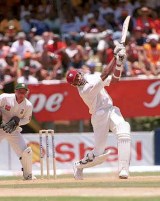Pakistan may have lost the first Test against South Africa at Centurion, but the bullish performance of their tail-end batsmen will live long in the memory. Here, Cricinfo recalls 11 other occasions when the lower-order adopted the long-handle approach

|

Darren Gough began his career with ten fours... not conceded but belted against the opposition
© Getty Images
|
|
Throughout the 1990s (and some might argue, the mid-2000s as well) tail-end collapses were a staple of the English cricketing experience. Against New Zealand in 1994, however, a young, brash fast bowler burst out of the pavilion at No. 9 and began clobbering the ball to all corners with the most gloriously outrageous follow-through since the days of Gilbert Jessop. Darren Gough's first act as a Test cricketer was to flog ten flamboyant fours in a match-turning and career-best 65. He added 130 for the eighth wicket with Phil DeFreitas, as England turned a precarious 235 for 7 into a series-sealing 382.
Gough's early career had the strangest effect on his team-mates, not least his fellow fast bowler, Devon Malcolm, a man who has staked a claim as the most inept tail-end batsmen of all time. England's omens weren't so good when they resumed the second day at Sydney on 198 for 7, but Gough led the fightback with a remarkable 56-ball onslaught. His innings began with the declaration as he marched out to bat: "Fasten your seatbelts!" and when it eventually ended on 51, Malcolm took over with the most spectacular display of slogging in his career. His Test-best 29 lasted just 18 balls, but included three fours and two monstrous mown sixes off Shane Warne. Turbo-charged by their efforts, Gough and Malcolm routed the Aussies for 116 in their first innings, but rain and dogged resistance denied England the win that would keep the Ashes alive.
It is debatable whether any of the 563 wickets that Glenn McGrath picked up in his illustrious Test career gave him quite the same satisfaction and jubilation as his maiden Test half-century. Prior to his innings, McGrath - who took his batting as seriously as any top-order stalwart - had been ribbed by his colleagues that his Test wickets tally (454) was closing in on his runs rally (477). But then he hit a rare six off Daniel Vettori to pass the 500 mark. He never looked back after that as he and Jason Gillespie added a rollicking 114 runs for Australia's tenth wicket. Gillespie also reached fifty for the first (but not the last) time, and celebrating by riding his bat down the middle of the wicket, to fulfil a pledge to his club team-mates in Adelaide.
Some days all it takes is one mighty swing of the blade. VRV Singh has few pretensions as a genuine batsman, but when he came to the wicket with his side in all sorts of strife at 205 for 9, there seemed little point in standing on ceremony. So he threw the kitchen sink at the first ball he received, from Jacques Kallis, and having successfully belted it through the covers for four, he tried the same trick again next ball, only this time with his eyes shut for good measure. By now he was sure that his eye was in, and what followed were 44 match-turning runs for the tenth wicket. Singh made 29 of them, with six lusty fours, and Sourav Ganguly an unobtrusive 51 not out. India had amassed a respectable 249, which soon became a formidable total, as a scrambled South Africa collapsed to 84 all out, and eventual defeat by 123 runs.
As he demonstrated this winter in Australia , Steve Harmison often prefers to save his best performances until after the fat lady has sung. So it proved with this fine display of biffing at Cape Town, as England 's year of reckoning in 2005 got off to the worst possible start. Harmison entered the fray at No. 11, a mere 248 runs short of victory. The stage was set for some flat-footed slogging, as he launched Shaun Pollock for 18 in an over before thumping Nicky Boje into the Railway Stand for six. By the time he had brought up a career-best 42, he had become only the seventh No. 11 batsman to top-score in a Test innings. But it wasn't quite enough to avert defeat.

|

The top order's collapse at 0 for 3 did not faze Kamran Akmal at Karachi
© AFP
|
|
One of the greatest Test turnarounds of all time was made possible by an eighth-wicket stand of 82 between Kamran Akmal and the irrepressible Shoaib Akhtar. Pakistan had been 0 for 3 after one over, thanks to Irfan Pathan's remarkable hat-trick, and 39 for 6 in the 11th. But Akmal played a brilliant counterattacking innings of 113 that would have made Adam Gilchrist proud, and he was joined by Shoaib at his indomitable best. India's bowlers abandoned the disciplines that had carried them into the ascendancy, as Shoaib, who had made a career-best 47 in the previous Test at Faisalabad, leathered the full length and avoided anything short. Pakistan 's eventual total of 245 was a mini-triumph, and they rode the wave all the way to a series-sealing 341-run win.
Nobody in the game slogs quite so gleefully as Muttiah Muralitharan. The contortions he performs when bowling are as nothing compared to the full-body wind-up he goes through with a bat in his hand - balls are there to be battered, as hard and far as possible. And his home ground at Kandy so often brings out the best in his ebullience, as India discovered during their three-Test visit in mid-2001. Sri Lanka looked to have squandered a precious first-innings lead when they slipped to 157 for 9, but Murali had other ideas and in 94 minutes of mayhem he slapped five fours and three sixes in a career-best 67. Ruchira Perera, his partner contributed just six runs to a 64-run stand for the tenth wicket. It would not, however, be enough to secure victory. Sourav Ganguly, in arguably his finest hour as a Test batsman, sealed the match with an unbeaten 98.
By the fifth and final Test of an arduous tour, England thought they had been startled enough times already by South Africa 's contortionist of a wrist-spinner, Paul Adams. His ridiculously home-spun bowling action, likened to a frog in a blender, had embarrassed the tourists in a warm-up match, and contributed to their near-downfall at Port Elizabeth. But it was with the bat at Newlands that he would make his most telling contribution of the series. England's woeful first innings of 153 had been matched by South Africa's collapse to 171 for 9, but then Adams and Dave Richardson got stuck in to Devon Malcolm, who bowled too short and too wildly with the new ball and was spanked for 26 runs in four overs. The pair added 73 for the tenth wicket, which would remain the highest score of the match. Another England collapse in the second innings handed South Africa the match by 10 wickets, and the series as well.

|

Walsh: possibly the greatest of tail-enders had his moments with the bat
© Cricinfo Ltd
|
|
They may have racked up more than 900 Test wickets between them, but Curtly Ambrose and Courtney Walsh were not renowned for their feats with the bat. Walsh especially was one of the great tail-enders - his determined grimace and crease-tapping stance could not disguise a career average of 7.54 and a record tally of 43 ducks. But his highest Test score of 30 not out came in the course of a 57-run stand for the ninth wicket with Ambrose at Melbourne. West Indies' last two wickets added 81 to secure a first-innings total of 280 that eventually proved sufficient to seal the series with two Tests remaining.
There's nothing quite like doing it all for yourself. With his first-innings figures of 7 for 62, Harbhajan Singh had already bowled India into a position of dominance against Sri Lanka at Ahmedabad, when he decided to let rip with the bat as well. He's never had the most conventional technique, but he's certainly got an eye for the ball, and in partnership with the circumspect Anil Kumble, he set about battering Sri Lanka out of the match. Ajit Agarkar had already applied several nails in their coffin with a 43-ball 48, but Harbhajan's unbeaten 40 from No. 11 was the final straw. He was denied a chance for a half-century by Virender Sehwag's declaration, but by way of compensation he was thrown the new ball, and finished up with ten wickets in the match.
There have been less effectual batsmen in the history of the game, but few looked as willfully vacuous as Alan Mullally as they went about their business. His lack of talent wasn't a patch on his lack of application, and during England's Ashes campaign in 1998-99 he managed five ducks and a 4 in his first six innings. The seventh, however, was a memorable awakening. Mullally's 16 from 15 balls included three cross-batted fours off a furious Glenn McGrath, who was not especially used to such dismissive treatment. At the time it looked like the last defiant twitch of a flat-lining team, as Australia were set a mere 175 for victory. But instead they collapsed to 162 all out. England's margin of victory was less than Mullally's tally of runs.
Andrew Miller is UK editor of Cricinfo





